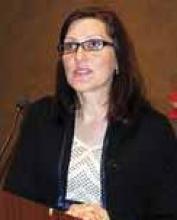In 2001, 3.3% of ED patients aged 65 years or older received a PPI. By 2010, this figure had climbed to 6.8%, a 104% increase. This trend is of particular concern because the elderly are the group at highest risk of PPI-related adverse events, including osteoporotic fractures, hypomagnesemia, drug-drug interactions, stent thrombosis, Clostridium difficile colitis, and community acquired pneumonia, Dr Mazer-Amirshahi noted.
Roughly half of patients who got a PPI in the ED during the study years did not have a clear gastrointestinal complaint as the primary reason for their visit, suggesting that much of the ED prescribing of PPIs was not for an approved indication, she continued.
Dr Mazer-Amirshahi observed that PPI prescribing has received special attention in the Choosing Wisely Program sponsored by the American Board of Internal Medicine, which recommends conducting a drug regimen review before prescribing a PPI in order to avoid drug-drug interactions. It’s also important to know whether a patient has osteoporosis before prescribing a PPI for longer than a few weeks. And there are additional reasons to think twice before prescribing a PPI in the ED.
“In the ED, we generally want to give our patients rapid symptom relief. PPIs have a delayed onset of action. They take 12-24 hours to take effect, so in many situations we might be better off giving an H2 blocker, which acts faster and is less costly,” she said.
Dr Mazer-Amirshahi reported having no financial conflicts regarding her study.
bjancin@frontlinemedcom.com
AEDs, not screening, most effective to prevent sudden cardiac death in athletes
BY: BIANCA NOGRADY
EXPERT OPINION FROM WCC 2014
MELBOURNE—Widespread availability of automated external defibrillators is far more likely than screening to prevent sudden cardiac deaths on the sports field, and has the added benefit of also preventing deaths off the sports field, said Dr N.A. Mark Estes, professor of medicine at Tufts University, Boston.
He said there were significant knowledge gaps around the sensitivity, specificity, and predictive accuracy of screening for sudden cardiac death in athletes, and existing screening guidelines were the subject of great criticism. “Each one of these deaths is tragic, and everyone understandably reacts in a fashion where they want to do something to prevent it,” Dr Estes, also director of the cardiac arrhythmia center at Tufts, said at the World Congress of Cardiology.
“The notion has arisen that in Italy they have an effective screening program that can identify athletes at risk of sudden cardiac death, so we should be able to do it in the United States.”
There are, however, significant differences between Italy and the United States, which made it unlikely that the success of the Italian screening efforts could be replicated here, he said.
“The Italians have specialized centers that are regional, they have highly skilled physicians, they have a demographic that’s completely different with a very homogeneous population base and a condition called ARVC [arrhythmogenic right ventricular cardiomyopathy] that you can effectively screen for with ECG and echocardiography.” Guidelines from the American College of Cardiology/American Heart Association currently recommend a 2-4 yearly history and physical examination for young athletes but, unlike Italy, they do not include an ECG.
The other challenge with screening is that, despite the extensive media coverage given to athletes’ deaths on the field, the condition is very rare, claiming around 150 lives each year on the sports field and 4,000 deaths off of it. Dr Estes said screening might result in significant numbers of athletes being excluded from the sports field even though we don’t know if restricting athletes from sport does in fact have an impact.
Instead, he argued in favor of greater availability of automated external defibrillators (AEDs) in public places and particularly recreation sites, with evidence showing survival rates above 75% for sudden cardiac death in participating high schools and colleges.
“We need to recognize that the effectiveness of the AED on the athletic field is extremely high, and we do have a way of preventing sudden death even though we can’t predict it, and the benefits for society go well beyond the athletic field,” Dr Estes said in an interview.
“If you look at the evidence, it tells us that screening hasn’t worked in the United States; it is epidemiologically and statistically highly improbable that it would ever work; so let’s put our money into something that’s going to have some proven benefits in a cost-effective fashion.”
Commenting on the presentation, Dr David Prior of St. Vincent’s Hospital, Melbourne, said he was supportive of the idea of secondary rather than primary prevention of sudden cardiac arrest.

